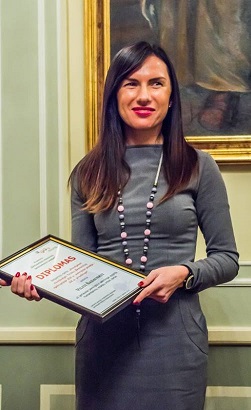Improving the decision making process by integrating multi-criteria decision making methods and building certification systems
Significant investments are being made in the construction sector in order to raise the quality of the buildings and make them more sustainable and energy-efficient. The key aspect of these investments should be the purposeful optimisation of the possible renovation and construction measures. However, this important matter is often being pushed aside in favour of construction price and/or quality.
In her doctoral thesis, Milena Medineckiene presents a tool that combines multi-criteria decision making (MCDM) methods and building certification systems in order to make weighted decisions in complicated construction tasks.
What is the topic of your Doctoral Thesis?

During my PhD studies, that I started in my native country Lithuania and finished here at KTH, I’ve been working with a topic, related to decision making in civil engineering tasks. The main tools, which I’ve used in my work, were multi-criteria decision making (MCDM) methods. In this dissertation I’m offering ideas about how to integrate MCDM together with buildings’ certification methods, in order to improve the decision making process. The problems and questions in this field need to be structured in a way that makes systematic decision making possible. I have focused on internationally recognized methods such as LEED, BREEAM, and a national certification system, the Swedish system Miljöbyggnad.
Why did you choose this topic?
Firstly, because of the the growing amount of renovated buildings, as well as the amount of new constructions in all of the Baltic Sea Region. The quality of most of these buildings could be at least a bit better. Besides reasons related to the low level of construction works, the planning processes in the early stages of buildings' designs are important. This is very closely related to the decision making processes. Another reason why I choose this topic is that in our capitalistic society there need to be more space for sustainable development, which is one of the main topics of all current researchers. In my dissertation I devote particular attention to the sustainable processes, which should be involved in construction planning and decision making for construction and renovation.
What are the most important results?
When I started working with MCDM tools, one of the most undiscovered things for me was how to solve the fact that different MCDM methods can show different outcomes. This absolutely denies the main idea of the tools’ applicability. But on the other hand, the algorithms which are used are proven mathematically, and can be adapted for the case studies and used for decision making processes. In my dissertation I’m offering an innovation, which, from one point of view, helps to solve the risk of different outcomes.
Did you come across something unexpected during your thesis research?
While working with the case studies, I’ve been interviewing respondents, such as building owners, in order to get their opinion on the main criteria, which are being used for constructing a decision making matrix. A difficulty which I’ve met was that it was often too complicated for people to express their preferences into a “pair-wise” comparison matrix, basing on the Saaty’s judgement scale. This was needed to give weight to criteria in decision making matrixes. So I offered a more simplified judgement scale, which is based on the percentage expression. I have described this in my dissertation.
Who will benefit from your results?
Decision making dilemmas are found in almost all research areas, as well as in ordinary everyday life. The main idea of the dissertation could be adapted to any decision making task, starting from buildings’ renovation and finishing with decisions, made in shopping centres. All of the criteria, which could describe the alternatives for the task, should be collected based on the particular case and related to the proven method. In the construction area, this offered innovation could be useful for the construction companies, municipalities or investors, who are going to build or renovate houses and want to plan their outcomes in advance. This will help them to make the right, weighted decisions, to be more social responsible and be in step with new innovations and sustainable development.
What will you do next?
I am developing some ideas. First of all I will work on the applicability of the new decision making methods. Another plan is to create an IT tool for consumers, to simplify their decision making, par it down to just a few simple steps. This tool could even be linked to local manufacturers. This could help provide information about prices, quality and amount of products for construction sites, and help make the decisions, choosing the best solution.
Milena Medineckiene defended her PhD thesis Integrated decision making in civil engineering, based on multi-criteria assessment and buildings’ certification in March 2017 within research area Building technology.